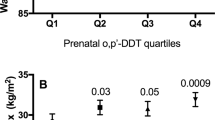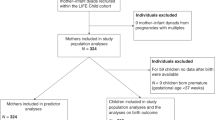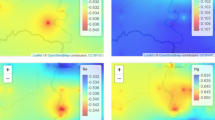Abstract
Objective:
To investigate the association between maternal pregnancy and estimated postnatal serum concentrations of the organochlorines 2,2′,4,4′,5,5′-hexachlorobiphenyl (CB-153) and 1,1-dichloro-2,2-bis(p-chlorophenyl)ethylene (p,p'-DDE) and body mass index (BMI) z-scores in 5- to 9-year-old children.
Methods:
Maternal sera from the INUENDO birth cohort (2002–2004) comprising mother–child pairs (N=1109) from Greenland, Warsaw (Poland), and Kharkiv (Ukraine) were analysed for CB-153 and p,p'-DDE, using gas chromatography-mass-spectrometry, and were grouped into tertiles for statistical analyses. A toxicokinetic model was used to estimate the first 12 months cumulative exposure to the compounds. Associations between these compounds and child age- and sex-specific BMI z-scores were calculated at follow-up (2010–2012), using multiple linear regression analysis.
Results:
No clear associations between pregnancy CB-153 and p,p'-DDE and child BMI were observed (the pooled differences in BMI z-score (95% confidence interval) comparing 3rd tertile to 1st tertile were −0.07 (−0.32 to 0.18) and −0.10 (−0.30 to 0.10) kg m−2, respectively). For postnatal CB-153 and p,p'-DDE and BMI, the overall differences in BMI z-score comparing 3rd tertile to 1st tertile were 0.12 (−0.15 to 0.39) and −0.03 (−0.20 to 0.27) kg m−2, respectively.
Conclusions:
This follow-up study of Greenlandic, Polish and Ukrainian populations showed no clear association between pregnancy and postnatal exposure to p,p'-DDE and CB-153 and BMI at the age of 5–9 years.
This is a preview of subscription content, access via your institution
Access options
Subscribe to this journal
Receive 12 print issues and online access
$259.00 per year
only $21.58 per issue
Buy this article
- Purchase on Springer Link
- Instant access to full article PDF
Prices may be subject to local taxes which are calculated during checkout
Similar content being viewed by others
References
Jacobson JL, Fein GG, Jacobson SW, Schwartz PM, Dowler JK . The transfer of polychlorinated biphenyls (PCBs) and polybrominated biphenyls (PBBs) across the human placenta and into maternal milk. Am J Public Health 1984; 74: 378–379.
Gladen BC, Schecter AJ, Papke O, Shkyryak-Nyzhnyk ZA, Hryhorczuk DO, Little RE . Polychlorinated dibenzo-p-dioxins, polychlorinated dibenzofurans, and coplanar polychlorinated biphenyls in breast milk from two cities in Ukraine. J Toxicol Environ Health A 1999; 58: 119–127.
Gladen BC, Monaghan SC, Lukyanova EM, Hulchiy OP, Shkyryak-Nyzhnyk ZA, Sericano JL et al. Organochlorines in breast milk from two cities in Ukraine. Environ Health Perspect 1999; 107: 459–462.
Czaja K, Ludwicki JK, Goralczyk K, Strucinski P . Organochlorine pesticides, HCB, and PCBs in human milk in Poland. Bull Environ Contam Toxicol 1997; 58: 769–775.
Dorea JG, Cruz-Granja AC, Lacayo-Romero ML, Cuadra-Leal J . Perinatal metabolism of dichlorodiphenyldichloroethylene in Nicaraguan mothers. Environ Res 2001; 86: 229–237.
Rogan WJ, Ragan NB . Some evidence of effects of environmental chemicals on the endocrine system in children. Int J Hyg Environ Health 2007; 210: 659–667.
Eubig PA, Aguiar A, Schantz SL . Lead and PCBs as risk factors for attention deficit/hyperactivity disorder. Environ Health Perspect 2010; 118: 1654–1667.
Boucher O, Muckle G, Bastien CH . Prenatal exposure to polychlorinated biphenyls: a neuropsychologic analysis. Environ Health Perspect 2009; 117: 7–16.
Ribas-Fito N, Sala M, Kogevinas M, Sunyer J . Polychlorinated biphenyls (PCBs) and neurological development in children: a systematic review. J Epidemiol Community Health 2001; 55: 537–546.
Hallgren S, Sinjari T, Hakansson H, Darnerud PO . Effects of polybrominated diphenyl ethers (PBDEs) and polychlorinated biphenyls (PCBs) on thyroid hormone and vitamin A levels in rats and mice. Arch Toxicol 2001; 75: 200–208.
Herbstman JB, Sjodin A, Apelberg BJ, Witter FR, Halden RU, Patterson DG et al. Birth delivery mode modifies the associations between prenatal polychlorinated biphenyl (PCB) and polybrominated diphenyl ether (PBDE) and neonatal thyroid hormone levels. Environ Health Perspect 2008; 116: 1376–1382.
Janesick A, Blumberg B . Endocrine disrupting chemicals and the developmental programming of adipogenesis and obesity. Birth Defects Res C Embryo Today 2011; 93: 34–50.
Newbold RR, Padilla-Banks E, Jefferson WN . Environmental estrogens and obesity. Mol Cell Endocrinol 2009; 304: 84–89.
Vom Saal FS, Nagel SC, Coe BL, Angle BM, Taylor JA . The estrogenic endocrine disrupting chemical bisphenol A (BPA) and obesity. Mol Cell Endocrinol 2012; 354: 74–84.
Goodman M, Lakind JS, Mattison DR . Do phthalates act as obesogens in humans? A systematic review of the epidemiological literature. Crit Rev Toxicol 2014; 44: 151–175.
Valvi D, Mendez MA, Martinez D, Grimalt JO, Torrent M, Sunyer J et al. Prenatal concentrations of polychlorinated biphenyls, DDE, and DDT and overweight in children: a prospective birth cohort study. Environ Health Perspect 2012; 120: 451–457.
Verhulst SL, Nelen V, Hond ED, Koppen G, Beunckens C, Vael C et al. Intrauterine exposure to environmental pollutants and body mass index during the first 3 years of life. Environ Health Perspect 2009; 117: 122–126.
Warner M, Aguilar Schall R, Harley KG, Bradman A, Barr D, Eskenazi B . In utero DDT and DDE exposure and obesity status of 7-year-old Mexican-American children in the CHAMACOS cohort. Environ Health Perspect 2013; 121: 631–636.
Mendez MA, Garcia-Esteban R, Guxens M, Vrijheid M, Kogevinas M, Goni F et al. Prenatal organochlorine compound exposure, rapid weight gain, and overweight in infancy. Environ Health Perspect 2011; 119: 272–278.
Cupul-Uicab LA, Hernandez-Avila M, Terrazas-Medina EA, Pennell ML, Longnecker MP . Prenatal exposure to the major DDT metabolite 1,1-dichloro-2,2-bis(p-chlorophenyl)ethylene (DDE) and growth in boys from Mexico. Environ Res 2010; 110: 595–603.
Verner MA, Sonneborn D, Lancz K, Muckle G, Ayotte P, Dewailly E et al. Toxicokinetic modeling of persistent organic pollutant levels in blood from birth to 45 months of age in longitudinal birth cohort studies. Environ Health Perspect 2013; 121: 131–137.
Toft G, Axmon A, Giwercman A, Thulstrup AM, Rignell-Hydbom A, Pedersen HS et al. Fertility in four regions spanning large contrasts in serum levels of widespread persistent organochlorines: a cross-sectional study. Environ Health 2005; 4: 26.
Jonsson BA, Rylander L, Lindh C, Rignell-Hydbom A, Giwercman A, Toft G et al. Inter-population variations in concentrations, determinants of and correlations between 2,2',4,4',5,5'-hexachlorobiphenyl (CB-153) and 1,1-dichloro-2,2-bis (p-chlorophenyl)-ethylene (p,p'-DDE): a cross-sectional study of 3161 men and women from Inuit and European populations. Environ Health 2005; 4: 27.
Sennbro CJ, Lindh CH, Tinnerberg H, Gustavsson C, Littorin M, Welinder H et al. Development, validation and characterization of an analytical method for the quantification of hydrolysable urinary metabolites and plasma protein adducts of 2,4- and 2,6-toluene diisocyanate, 1,5-naphthalene diisocyanate and 4,4'-methylenediphenyl diisocyanate. Biomarkers 2003; 8: 204–217.
de Onis M, Onyango AW, Borghi E, Siyam A, Nishida C, Siekmann J . Development of a WHO growth reference for school-aged children and adolescents. Bull World Health Organ 2007; 85: 660–667.
Strauss RS . Effects of the intrauterine environment on childhood growth. Br Med Bull 1997; 53: 81–95.
Pala V, Lissner L, Hebestreit A, Lanfer A, Sieri S, Siani A et al. Dietary patterns and longitudinal change in body mass in European children: a follow-up study on the IDEFICS multicenter cohort. Eur J Clin Nutr 2013; 67: 1042–1049.
Timmermans SH, Mommers M, Gubbels JS, Kremers SP, Stafleu A, Stehouwer CD et al. Maternal smoking during pregnancy and childhood overweight and fat distribution: the KOALA Birth Cohort Study. Pediatr Obes 2013; 9: e14–e25.
Shi Y, De Groh M, Morrison H . Perinatal and early childhood factors for overweight and obesity in young Canadian children. Can J Public Health 2013; 104: e69–e74.
Haugaard LK, Ajslev TA, Zimmermann E, Angquist L, Sorensen TI . Being an only or last-born child increases later risk of obesity. PLoS One 2013; 8: e56357.
Dubois L, Girard M . Early determinants of overweight at 4.5 years in a population-based longitudinal study. Int J Obes (Lond) 2006; 30: 610–617.
Schuch I, Castro TG, Vasconcelos Fde A, Dutra CL, Goldani MZ . Excess weight in preschoolers: prevalence and associated factors. J Pediatr (Rio J) 2013; 89: 179–188.
Sterne JA, White IR, Carlin JB, Spratt M, Royston P, Kenward MG et al. Multiple imputation for missing data in epidemiological and clinical research: potential and pitfalls. BMJ 2009; 338: b2393.
Donders AR, van der Heijden GJ, Stijnen T, Moons KG . Review: a gentle introduction to imputation of missing values. J Clin Epidemiol 2006; 59: 1087–1091.
Cupul-Uicab LA, Klebanoff MA, Brock JW, Longnecker MP . Prenatal exposure to persistent organochlorines and childhood obesity in the U.S. Collaborative perinatal project. Environ Health Perspect 2013; 121: 1103–1109.
Hertz-Picciotto I, Charles MJ, James RA, Keller JA, Willman E, Teplin S . In utero polychlorinated biphenyl exposures in relation to fetal and early childhood growth. Epidemiology 2005; 16: 648–656.
Jusko TA, Koepsell TD, Baker RJ, Greenfield TA, Willman EJ, Charles MJ et al. Maternal DDT exposures in relation to fetal and 5-year growth. Epidemiology 2006; 17: 692–700.
Patandin S, Koopman-Esseboom C, de Ridder MA, Weisglas-Kuperus N, Sauer PJ . Effects of environmental exposure to polychlorinated biphenyls and dioxins on birth size and growth in Dutch children. Pediatr Res 1998; 44: 538–545.
WHO Multicentre Growth Reference Study Group. WHO Child Growth Standards based on length/height, weight and age. Acta Paediatr Suppl 2006; 450: 76–85.
Acknowledgements
The CLEAR (Climate change, environmental contaminants and reproductive health, http://www.inuendo.dk/clear) and INUENDO (Biopersistent organochlorines in diet and human fertility) studies were funded by the European Commission’s 7th and 5th Framework Programmes, respectively (grants FP7-ENV-2008-1-226217 and QLK4-CT-2001-00202).
Author information
Authors and Affiliations
Corresponding author
Ethics declarations
Competing interests
The authors declare no conflict of interest.
Additional information
Supplementary Information accompanies this paper on International Journal of Obesity website
Rights and permissions
About this article
Cite this article
Høyer, B., Ramlau-Hansen, C., Henriksen, T. et al. Body mass index in young school-age children in relation to organochlorine compounds in early life: a prospective study. Int J Obes 38, 919–925 (2014). https://doi.org/10.1038/ijo.2014.58
Received:
Revised:
Accepted:
Published:
Issue Date:
DOI: https://doi.org/10.1038/ijo.2014.58
Keywords
This article is cited by
-
Dichlorodiphenyltrichloroethane for Malaria and Agricultural Uses and Its Impacts on Human Health
Bulletin of Environmental Contamination and Toxicology (2023)
-
Prenatal exposure to persistent organic pollutants and metals and problematic child behavior at 3–5 years of age: a Greenlandic cohort study
Scientific Reports (2021)
-
Chronic oral exposure to pesticides and their consequences on metabolic regulation: role of the microbiota
European Journal of Nutrition (2021)
-
Maternal Exposure to Synthetic Chemicals and Obesity in the Offspring: Recent Findings
Current Environmental Health Reports (2015)



